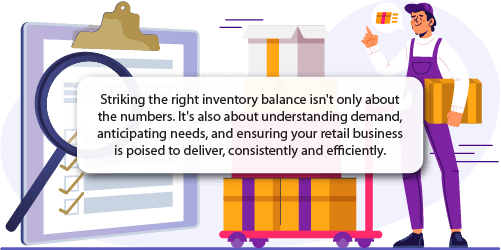In the bustling arena of retail, the quest for the perfect inventory balance stands paramount. It's a delicate equilibrium that separates thriving businesses from those teetering on the edge. For retailers, striking this balance means ensuring products are always available, yet without excess, safeguarding profits while simultaneously delivering the seamless shopping experience customers have come to expect and cherish.

The "why" of inventory planning is rooted in its profound impact on a retailer's success. A misstep can erode profits, tarnish brand reputations, and disappoint loyal customers. Conversely, adept inventory management can enhance profitability, foster trust, and build a resilient brand. It's not just about numbers; it's about crafting a shopping experience that keeps customers returning.
So, how do retailers navigate this intricate dance of supply and demand? It comes down to strategic inventory management, blending advanced technological tools with seasoned intuition. It's about harnessing data, understanding market nuances, and staying agile amidst shifting consumer preferences. This journey towards optimal inventory balance is intricate, but with the right strategies, retailers can transform a daunting challenge into a tangible achievement.

What causes inventory imbalances?
Achieving the optimal inventory level is a juggling act many retailers face. Too much or too little, and the balance is lost, leading to financial losses or unsatisfied customers.
But why do inventory imbalances occur? There are several reasons.
Inaccurate demand forecasting
Predicting consumer demand is foundational for inventory management. A misstep here can cause stockouts or overstocks.
For example, when Apple launched its iPhone 7 Plus, it underestimated its demand. Many stores faced stockouts within hours, leaving potential customers empty-handed and looking to competitors or alternative options.
Supply chain disruptions
The interconnected nature of global commerce means disruptions in one part can echo across the chain.
The 2020 COVID-19 pandemic stands as a potent example. It created unexpected bottlenecks, from halted productions in Asia to shipping delays globally. Such disruptions led to widespread stockouts, particularly in the electronics and home fitness sectors.
Seasonal variations
Inventory demands can fluctuate with seasons or events. Retailers who misjudge these swings risk overstocks or stockouts. After festive seasons, stores like Walmart or Target often have surplus holiday decorations or themed items, leading to discounted sales to clear stock.
Competitive actions
The retail landscape is fiercely competitive. A rival's marketing campaign, flash sale, or new product launch can divert customers, impacting anticipated sales.
When Amazon introduced 'Prime Day', many competitors faced reduced sales, leading to overstocked items, as customers flocked to Amazon's deals.
Lead time misjudgment
Every product has a lead time – the duration between placing an order and its arrival. Misjudging this can result in premature or delayed product arrivals.
A classic example is the fashion industry, where trends change rapidly. Delays can mean clothing arrives when a trend has faded, resulting in overstocks
Obsolete inventory
In an ever-evolving market, products can quickly become outdated. Retailers holding onto such products risk overstocks. When e-books surged in popularity, many bookstores were left with physical books that struggled to sell, exemplifying the challenges of an industry in transition.
Inventory imbalances, while challenging, are manageable. By understanding these root causes, retailers can take informed steps to prevent or mitigate their effects, steering their business toward sustainable success.

What are the consequences of inventory imbalances?
When balanced, you have inventory that allows for smooth operational flow and steady profitability. However, any imbalance, whether too much or too little, can have cascading effects on both the retailer and its customers.
Financial strain
One of the most immediate impacts of inventory imbalances is on a retailer's bottom line.
Overstocks mean tied-up capital in unsold goods, which affects cash flow. These unsold items often lead to markdown sales, squeezing profit margins.
Operational challenges
Stockouts often trigger a chain reaction of operational hiccups. Rushing to restock can lead to expedited shipping fees, straining the budget. On the flip side, overstocks require additional storage, leading to increased warehouse costs.
Toys "R" Us, during the 2017 holiday season, experienced stockouts of popular items, leading them to expedite shipments at substantial costs.
Brand reputation and customer loyalty
In today's digital age, consumer feedback is swift and public. Frequent stockouts can lead to negative reviews and a damaged reputation. Customers expect product availability and consistent stockouts can push them to competitors.
Conversely, chronic overstocks and subsequent sales can devalue a brand. Gap, in the past, faced challenges with stockouts of popular sizes, leading to customer dissatisfaction and lost sales.
Reduced flexibility
Overstocks can diminish a retailer's flexibility in adapting to market trends. With significant capital tied up in unsold inventory, there's less room to invest in new, trending products.
BlackBerry faced this issue with its PlayBook tablet. Overestimating its demand, it had significant unsold stock, hindering its ability to pivot to newer technologies and designs.
Environmental and ethical concerns
Overproduction and overstock, particularly in the fashion industry, lead to wastage. Brands, at times, destroy unsold luxury goods to maintain their exclusivity. This not only has environmental repercussions but also raises ethical questions, especially when considering global issues like sustainability and waste management.
Fast fashion brands have been under scrutiny for the environmental impact of their overproduction.
Lost sales opportunities
Perhaps the most straightforward consequence of stockouts is missed sales. When a customer is ready to purchase, but the product is unavailable, it's a direct loss of revenue. For online retailers, this can also mean increased cart abandonment rates.
The consequences of inventory imbalances go beyond mere numbers. They ripple out, affecting operations, brand image, customer relationships, and even broader societal and environmental issues. Recognizing these repercussions underscores the imperative of achieving - and maintaining - that pivotal inventory balance.

How can you strike the right inventory balance?
Striking the right inventory balance is vital for the sustained success of a retailer. While challenges abound, understanding the root causes of these imbalances can pave the way for solutions.
Refine demand forecasting
Invest in sophisticated forecasting tools that utilize AI and machine learning. These tools analyze past sales data, consider external factors like market trends, and adjust predictions accordingly.
For example, after facing stockouts during the iPhone 4 launch, Apple made substantial improvements to its demand forecasting, leading to more efficient subsequent product launches.
Strengthen supply chain resilience
Diversify suppliers and maintain open communication lines. This ensures a backup when one supplier faces disruptions.
After the COVID-19-related supply chain bottlenecks, companies like Nike began to diversify their manufacturing hubs to prevent future disruptions.
Plan for seasonal variations
Employ just-in-time (JIT) inventory management. By receiving goods only when they're about to be sold, retailers can minimize overstocks post-season. Target, leveraging JIT, can effectively manage its inventory, reducing post-season clearance sales.
Stay alert to trends and be personal
Implement real-time tracking systems that monitor competitors' activities. This allows for a swift reaction to any market shifts. Sephora, for example, offers a personalized experience, allowing it to offer timely deals or introduce trending products promptly.
Optimize lead times
Engage in regular communication with suppliers, ensuring timely updates on any potential delays. Advanced analytics can also help predict lead times based on historical data. Zara, renowned for its fast fashion model, excels in this, ensuring that its products arrive timely, aligned with current fashion trends.
Manage obsolete inventory
Incorporate a systematic review process to identify and phase out obsolete stock. Markdown strategies or bundling can help move this inventory. Retailers, faced with the challenge of selling obsolete electronics, often bundle them with trending items, offering them at discounted rates.
Achieving inventory balance isn't merely about numbers; it's about leveraging technology, maintaining robust communication, and staying agile in an ever-evolving market.
By directly addressing the root causes of imbalances, retailers can not only prevent stockouts or overstocks but also set the stage for sustainable growth and customer satisfaction. Remember, in retail, balance isn't just a goal; it's a continuous journey.
Conclusion
Achieving the right inventory balance is a testament to impeccable inventory planning and astute inventory management. For retailers, this harmony is a cornerstone of success. Dive deeper into mastering retail nuances; subscribe to our newsletter for invaluable tips and the latest insights.


